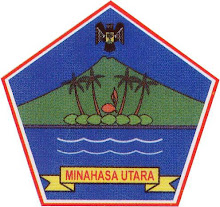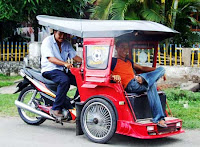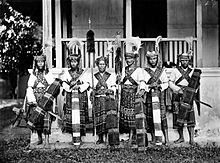Sitaro Islands Regency (Indonesian:
Kabupaten Sitaro, full name:
Kabupaten Kepulauan Siau Tagulandang Biaro) is a
regency located in Sangihe Islands,
North Sulawesi, Indonesia. The regency was formed basing on
Law Number 15 Year 2007 from January 2, 2007 (Indonesian:
Undang-Undang Nomor 15 Tahun 2007). The regency's area is 275,96 km² and total population is 64,987 people. Most of the population are fishers and farmers. The majority's of the population religion is Christianity and Catholicism, but there are also followers of Islam and Buddhism.
Regency of the islands of Siau, Tagulandang and Biaro is a bunch of 47 (forty-seven group of islands lies in Nusa Utara (North Island). The Regency is the developing result from the Sangihe regency officially stands as an autonomy on January 2nd, 2007.
The characteristic of those island are 80% of this region is marine area which deposits a million tourism objects were fascinating and enjoyable to visit. Beach tour, Marine tour and Echo tourism are the first class tourism in the island of SITARO regency.
As a bunch of islands in Nusa Utara, the islands of SITARO Regency has potential deposits beach tour less no interest beauty from another place as a famous in Indonesia. Its unique lies on the beach on the foot mountains. So not only special beach serve the view but also it can give another exotic view for the wall climbing, Sitaro beach promises you the spots of Black Stone Walls that already never explored.
Culture Tourism
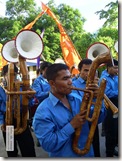
There are three big ethnics in the island of Sitaro: Siau, Tagulandang and Biaro. Those ethnic living influenced by Sangihe Culture formed habitually and the culture from the ancient to the next generation that it can be exploration. The custom party of “TULUDE” is one of the big and completed events held on yearly. The local smart people served words by ‘MASAMPER” is a harmonies talent of nature singing in a groups. The “Musik Bambu” (Bamboo) and the “Musik Bia” (music tools from shell) is the traditional music. You can find some of traditional dance completed with the custom cloth and also there are symbols of custom usually using by the leaders of custom called “Kasili and Sangiang”
Underwater Tourism
The Echo Tourism. The Regency of the islands of
SITARO also is the very exact place to make the echo tourism. The scientist, the academicians and the environmentalist can doing research while making tour. There are a couple of spots waiting for their touch.
The massage spot and to lay on the egg for whale. Lies under the seas of Biaro Island. According to the first research this spot is a place for gathering a school of whale from Pacific oceans, on the marriage and to lay on their egg.
The Coral. On of the marine riches lies almost all of the Regency of the SITARO Islands must be explore. The Paradise for fishing the coral fish easy to reach just take a walk from the border of the beach when low tide, called “Nyare” (local dialect) and also as a source living for local people. The view underwater creature as like as coral bed deposits the exotic nature that never exploit. The seas garden in Biaro Island waiting for exploration by the smart diver.
Marine Tourism
 Makalehi Island.
Makalehi Island. Lies on the west from Siau Island like a lonely island in the ocean. It deposits a huge fishing potential. You can enjoy the fisherman activity sail on their boat (Pajeko). In the center of the island there is a lake with the unique landscape.
 Mahoro Island.
Mahoro Island. Occupied on the east from Siau Island. The island is heaven for the Wallet Bird. The cave is the home for Wallet Bird as an unique of the nature. White sandy beach and soft lies around the island. This is the best spot for snorkeling and diving.
 Pasige Island
Pasige Island. This island is unoccopied, little island, diagonal close from Tagulandang island, it’s unique is when the very high tide. This island almost sinking. The heaven of domestic birds and the coral fish in laying their eggs. Good for fishing.
Tour of Nature
The real volcano of mount Karangetang is the “icon” of Siau Island. The volcano
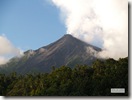
mount called “Custom Mount” (by local people). Deposit a million mystery to research the magma never sleeps from the activity made the top of the mount fire continually serve a unique view in the night. The south of mount, there is a Ruang Volcano Mount, the silent volcano, half of the mount cut off by heavy erupted. This volcano mount is the port of Tagulandang Harbor.
Rare Fauna. There are two species rare in the SITARO Regency “Celepuk Siau” (
otus siaoensis) and “Tarsier Siau Island.” The two species is the rare fuana is listed in the WWF. Celepuk Siau is like an owl, in the category of
critically endangered. Very exactly doing the tour of nature while trying to identifying both of those fauna.
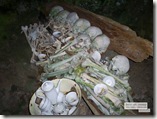 Tembo Yonding (Yonding Head)
Tembo Yonding (Yonding Head). There are a group of skull complete with a million mystery. You can find them in the cave that hang on the stonewall in the Makalehi island. This skeleton is complete and very popular because not all of the people can take a picture in success to develop it. It is very mystery because no one knows this group of the skeleton since the island occupied. Needs to research.
You can check many tourism site of this Regency in here or Tourism Page.










 There are three big ethnics in the island of Sitaro: Siau, Tagulandang and Biaro. Those ethnic living influenced by Sangihe Culture formed habitually and the culture from the ancient to the next generation that it can be exploration. The custom party of “TULUDE” is one of the big and completed events held on yearly. The local smart people served words by ‘MASAMPER” is a harmonies talent of nature singing in a groups. The “Musik Bambu” (Bamboo) and the “Musik Bia” (music tools from shell) is the traditional music. You can find some of traditional dance completed with the custom cloth and also there are symbols of custom usually using by the leaders of custom called “Kasili and Sangiang”
There are three big ethnics in the island of Sitaro: Siau, Tagulandang and Biaro. Those ethnic living influenced by Sangihe Culture formed habitually and the culture from the ancient to the next generation that it can be exploration. The custom party of “TULUDE” is one of the big and completed events held on yearly. The local smart people served words by ‘MASAMPER” is a harmonies talent of nature singing in a groups. The “Musik Bambu” (Bamboo) and the “Musik Bia” (music tools from shell) is the traditional music. You can find some of traditional dance completed with the custom cloth and also there are symbols of custom usually using by the leaders of custom called “Kasili and Sangiang” Makalehi Island. Lies on the west from Siau Island like a lonely island in the ocean. It deposits a huge fishing potential. You can enjoy the fisherman activity sail on their boat (Pajeko). In the center of the island there is a lake with the unique landscape.
Makalehi Island. Lies on the west from Siau Island like a lonely island in the ocean. It deposits a huge fishing potential. You can enjoy the fisherman activity sail on their boat (Pajeko). In the center of the island there is a lake with the unique landscape. Mahoro Island. Occupied on the east from Siau Island. The island is heaven for the Wallet Bird. The cave is the home for Wallet Bird as an unique of the nature. White sandy beach and soft lies around the island. This is the best spot for snorkeling and diving.
Mahoro Island. Occupied on the east from Siau Island. The island is heaven for the Wallet Bird. The cave is the home for Wallet Bird as an unique of the nature. White sandy beach and soft lies around the island. This is the best spot for snorkeling and diving. Pasige Island. This island is unoccopied, little island, diagonal close from Tagulandang island, it’s unique is when the very high tide. This island almost sinking. The heaven of domestic birds and the coral fish in laying their eggs. Good for fishing.
Pasige Island. This island is unoccopied, little island, diagonal close from Tagulandang island, it’s unique is when the very high tide. This island almost sinking. The heaven of domestic birds and the coral fish in laying their eggs. Good for fishing. mount called “Custom Mount” (by local people). Deposit a million mystery to research the magma never sleeps from the activity made the top of the mount fire continually serve a unique view in the night. The south of mount, there is a Ruang Volcano Mount, the silent volcano, half of the mount cut off by heavy erupted. This volcano mount is the port of Tagulandang Harbor.
mount called “Custom Mount” (by local people). Deposit a million mystery to research the magma never sleeps from the activity made the top of the mount fire continually serve a unique view in the night. The south of mount, there is a Ruang Volcano Mount, the silent volcano, half of the mount cut off by heavy erupted. This volcano mount is the port of Tagulandang Harbor. Tembo Yonding (Yonding Head). There are a group of skull complete with a million mystery. You can find them in the cave that hang on the stonewall in the Makalehi island. This skeleton is complete and very popular because not all of the people can take a picture in success to develop it. It is very mystery because no one knows this group of the skeleton since the island occupied. Needs to research.
Tembo Yonding (Yonding Head). There are a group of skull complete with a million mystery. You can find them in the cave that hang on the stonewall in the Makalehi island. This skeleton is complete and very popular because not all of the people can take a picture in success to develop it. It is very mystery because no one knows this group of the skeleton since the island occupied. Needs to research.